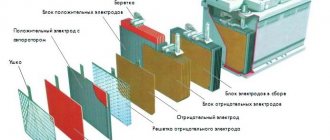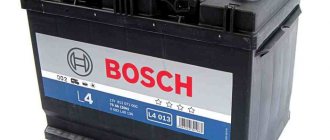A hydrometer is a device that measures the density of liquids. Car owners can use it in two cases. The first is to check the density of the electrolyte to find out the condition of the battery. The second is to find out the density of antifreeze. The freezing temperature of the coolant depends on this parameter.
Hydrometers for electrolyte and antifreeze can be either universal or separate devices. When servicing a car with your own hands, you must know how to properly use each of them in one case or another.
How to use a hydrometer and why is it needed?
The hydrometer works based on Archimedes' principle. It is used to find out the density of any liquids. Depending on what material is being tested, a corresponding scale is applied inside the device. For the car owner, the main thing is to understand the readings of the scale responsible for the density of antifreeze and electrolyte. These two liquids have different densities, so they need different scales for measurement.
Most car hydrometers are universal - they simply have two separate scales. But there are also devices for each of the liquids.
Example of a hydrometer with three scales
The densities of battery electrolyte and antifreeze are measured in g/cm³, so most often the scale is calibrated in these units. But sometimes devices can also be marked in kg/m³. Also, in some devices, the scale for antifreeze can be immediately marked in degrees Celsius, which indicate the freezing point of the liquid. If not, you need to use the table of temperature versus density, which you will find below in the corresponding section.
The hydrometer itself consists of a thin glass or plastic tube, sealed on both sides, and with a graduated scale inside. One end of the tube is shaped like a ball or bulb and contains a load of small metal shot. The weight causes the device to float vertically in the liquid like a float.
To make it easier to work with hazardous liquids, the best automotive hydrometers have a safer design. They have a second cylinder (glass or plastic), which acts as a flask - using a bulb, the liquid to be measured is drawn into it, and inside it is the hydrometer itself. As a result, the hydrometer floats inside the flask without touching its walls and measures the density of the substance. The bulb also allows you to safely return the collected fluid back to the battery or antifreeze expansion tank. This design also allows you to measure the density of liquids in which it is technically difficult to place a hydrometer.
There are digital hydrometers, but they are rarely used by car owners because they are many times more expensive than analog instruments.
In some sources, digital hydrometers are called refractometers. This is fundamentally wrong - a refractometer is a fundamentally different device that uses the refractive index of light in a medium for measurements. Although this device can also effectively measure the density of the electrolyte and the freezing point of antifreeze.
When buying a hydrometer, choose a device with a scale of the maximum size. The larger the scale, the more divisions and the easier it will be for you to take measurements. And for the same electrolyte, every 0.01 g/cm³ is important. When choosing the material from which it will be made, keep in mind that plastic may become cloudy over time, but it is safe to use. Glass allows for more accurate measurements, but requires care and careful storage so as not to break the device.
Safety precautions when working with a car hydrometer
When starting to measure the density of an electrolytic liquid, do not forget that it is diluted hydrochloric acid - a chemically aggressive liquid that can cause severe burns if it comes into contact with unprotected areas of the skin.
Therefore, when working with a hydrometer, it is necessary to adhere to the appropriate safety precautions:
- put on a rubber apron;
- protect your hands with rubber gloves;
- work only with safety glasses.
Acid getting into your eyes can cause vision loss!
In winter, it is necessary to check the density of the battery electrolyte with a hydrometer in a heated room.
If electrolyte gets on unprotected skin or eyes, you should immediately rinse the affected areas with running water, and the procedure should last at least 15 minutes. After this, you should prepare an aqueous solution of soda (200 ml teaspoon of soda) or use soapy water to apply to the burned areas of the skin - this way you will neutralize the effect of the acid as much as possible with an alkaline solution.
After this, you should call an ambulance or, if possible, go to the nearest hospital yourself to provide further medical care.
How to measure with a hydrometer
First, squeeze the hydrometer bulb and place the device in the liquid. Smoothly releasing the bulb, fill the flask with the substance being measured. Swirl the hydrometer slightly to remove any air bubbles. Hold the device vertically and wait until the hydrometer inside stops in one place. It is important that it does not touch the walls of the flask! The mark at which the liquid level coincides with the hydrometer scale is the density value of this liquid.
It is important to measure density with a hydrometer at a temperature of about 20 degrees. If the temperature of the substance being measured is different, then the readings must be adjusted in accordance with the table below.
| Temperature of the measured liquid, °C | -20°С | -10°С | 0°C | 10°C | 20°C | 30°С | 40°C | |
| Correction amount | For electrolyte, g/cm³ | -0,035 | -0,025 | -0,014 | -0,007 | 0 | +0,007 | +0,014 |
| For antifreeze, °C | +27 | +21 | +12 | +5 | 0 | -7 | -12 | |
If you still have questions about how to use a hydrometer, watch these videos:
What is a hydrometer for and how to use it
It is important to consider that several factors influence the accuracy of hydrometer measurements.
- Cleanliness - all components of the device must be clean, especially the bulb and scale. Therefore, the device must be thoroughly washed after each use.
- Temperature - it is better that the hydrometer and the liquid being measured are at the same temperature as the environment (ideally 20°C). This will prevent the density from changing during testing and the readings will be more accurate.
- Device design - the outer vessel must have a diameter 2-2.5 centimeters larger than the measuring element itself, so that the hydrometer can float freely in the liquid without touching the walls. The hydrometer touching the flask gives incorrect measurements.
Why are they needed and what are they?
Hydrometers are used to measure the specific density of liquids and, according to their purpose, are often called density meters. Existing devices today are divided into two classes:
- Constant volume.
- Constant mass.
The operation of devices of both classes is based on Archimedes' law, although they measure density using completely different methods.
Constant volume devices
The classic densitometer of this type is a small cup or a hollow ball with a cup, on the side of which there is a line. To measure, a cup (ball) is lowered onto the surface of the liquid and, using different-sized weights included in the kit, the device is submerged to the line. Then the total weight of the weights is calculated, which is converted into specific density using a special table. Constant mass hydrometers have high accuracy, are simple in design, and cheap, but due to the rather painstaking and lengthy measurement process, they have become widespread only as laboratory ones.
Hydrometer for measuring the characteristics of alcohol-containing liquids (spirometer)
Constant mass density meters
The device is a sealed flask - a float, in the lower part of which there is a weight of a certain and constant mass. The upper part of the float is graduated in certain units. Since the volume and mass of the device are constant, the depth of its immersion directly depends on the density of the liquid. To measure, the hydrometer is immersed in liquid and the readings are read directly from the scale. Obviously, working with such a device is much easier , and it is for this reason that constant mass density meters, or otherwise densimeters, are widely used in almost all areas, including household ones.
We recommend: Characteristics and features of the Bosch S4 004 battery
A constant mass hydrometer sinks the more, the denser (heavier) the liquid
There is another type of hydrometer for batteries, which have a set of floats of the same volume, but different weights. Measurement with such a device is carried out by immersing all the floats in liquid at once, and the density is determined by the number of floats/sanks.
This electrolyte density meter uses 7 floats, each of which reacts by floating only to its “own” density
Densimeters of this type have low accuracy and are usually called density indicators.
How to use a battery hydrometer
In addition to universal hydrometers with a bulb, separate devices are used for electrolytes, only for this liquid. These are models such as Vympel AR-02 5002, Heyner Premium 925 010, JTC 1041, Orion AR-2, Sparta 549125.
Orientation according to the color markings of the hydrometer
Often, hydrometers, in addition to the usual scale, also have color markings - for example, green indicates a normal level, red indicates a very low level, etc.
A car hydrometer allows you to measure the density of the battery electrolyte and thus determine what to do next: either how much water needs to be added, or how much acid to add.
In the case of an electrolyte, measurements are complicated by its transparency. Therefore, it is better to first lower your eye below the surface of the electrolyte, and then slowly raise your gaze until the elliptical surface becomes a straight line. The point at which the line is located on the hydrometer scale will be the hydrometer reading.
Checking battery density with a hydrometer at home
The process of properly using a hydrometer to measure the density of the electrolyte in a car battery.
The algorithm for measuring the density of electrolyte with a hydrometer with a bulb is as follows:
- The battery should sit for about 6 hours, and the electrolyte inside should reach room temperature, about 20°C.
- Unscrew the battery plugs.
- Place the hydrometer in the first jar and collect the electrolyte.
- Wait until the hydrometer stops moving and record the measurement result.
- Repeat the procedure for each jar.
- Based on the measurement results, decide how much water to add. Instructions are here.
The dependence of the charge level on the electrolyte density is in the table below.
| Charge percentage | Electrolyte density, g/cm3 | Battery voltage, V |
| 100% | 1,28 | 12,7 |
| 80% | 1,245 | 12,5 |
| 60% | 1,21 | 12,3 |
| 40% | 1,175 | 12,1 |
| 20% | 1,14 | 11,9 |
| 0% | 1,10 | 11,7 |
Remember that electrolyte contains acid, so it is important to follow all safety precautions. Wear gloves to prevent electrolyte from coming into contact with skin, clothing or other surfaces.
How to use a stick battery hydrometer
What does a hydrometer look like with sticks inside?
There are also hydrometers of a special design - with “sticks” inside. The meaning of their work is that when the container is filled with electrolyte, a plastic stick corresponding to a certain density floats up. The marking is applied to the body, opposite each stick (float).
But judging by the reviews, this is not a very reliable device - the sticks do not always float up, or several of them float up at once to different heights (the lightest is the highest). Because of this, it is difficult to determine what the actual density of the electrolyte being tested is.
To correctly check the density with such a hydrometer, you need to take your time. Having collected the electrolyte into the flask, wait about 10 seconds. When the measurement occurs on the edge of the density of the last floating stick, it floats up with a delay.
There are actually several options for such a hydrometer for a battery with stripes, one with colored stripes (from white - 1.19 to green - 1.27 and then red and brown, when the density is higher than necessary ), and the second with floats of the same color. They emerge not one at a time, but several at once ( if four emerge, then the density is normal ).
What is density and what does it affect?
An essential element of a lead-acid battery is the electrolyte. This is sulfuric acid diluted with distilled water. The density of water is 1 gram per milliliter (g/ml). For sulfuric acid it is higher than for water, and is 1.84 g/ml. Concentrated acid can dissolve many metals, including lead, so it should be diluted with water. An acid diluted with water is called an electrolyte. It is diluted to a proportion at which it is unable to dissolve the lead, but allows a chemical process called electrolytic dissociation (a type of electrolysis) to occur.
The higher the density, the stronger the electrolysis, but the faster the destruction of lead. The most optimal density for batteries is 1.27 g/ml for temperate climate areas with an average temperature of -20 to +30°C. This is the density of a fully (100%) charged new battery. For northern regions this value is 1.29 g/ml, for southern hot climates - 1.25 g/ml.
Sulfuric acid goes on sale already in the form of an electrolyte with a density of 1.3 g/ml. Taking into account the operating conditions of the battery, it is adjusted to the required parameters.
As noted above, the greater the density of the electrolyte, the stronger the electrolysis and the higher the potential at the battery terminals. The new battery has a density of 1.27 g/ml and a voltage at the terminals of 12.8 V. During the operation of the battery, with regular undercharging, insoluble lead sulfate, a compound of sulfuric acid with lead, forms on its lead plates. This is called plate sulfation. When the battery is charged, not all the acid is released, and the density of the electrolyte decreases. And consequently, the intensity of electrolysis decreases. The voltage at the terminals will be less than 12.8 V. And an attempt to charge the battery to the initial voltage value only leads to boiling of the electrolyte - the active release of hydrogen and oxygen bubbles. This is the process of water decomposition. Loss of water leads to increased density.
Expert opinion
Alexey Bartosh
Specialist in repair and maintenance of electrical equipment and industrial electronics.
Ask a Question
Too high or low density is equally unacceptable and significantly reduces the service life of the battery.
Under vehicle operating conditions with frequent engine starts and short mileage, accelerated sulfation of the plates occurs and a decrease in the density of the electrolyte. When operating vehicles on long-distance flights with long-term engine operation, the battery is recharged and water decomposes into gases, and the density of the electrolyte increases. The voltage at the terminals no longer reflects the state of charge of the battery. And in order to accurately determine the condition of the battery, you need to measure the density of the electrolyte. A hydrometer is used for this.
A hydrometer is a device for measuring the density of liquids and solids, the operating principle of which is based on Archimedes' Law.
Differences between hydrometers by purpose
Despite the fact that almost all hydrometers are used to measure density and operate on the same principle, they can have different purposes, which must be taken into account when choosing a device. According to existing state standards, density meters are divided into the following types:
- General purpose devices.
- Densimeters for electrolyte. Serves to control the density of the acid electrolyte in the battery.
- For petroleum products. They are used to measure the quality of petroleum products.
- Alcohol meters. Shows the quantitative alcohol content in alcoholic drinks.
- Lactometers. Allows you to determine the fat content and other characteristics of milk.
- Medical. To check the specific density of urine during laboratory tests.
- Sugar meters. Allows you to measure the amount of sugar in a liquid.
- Salt meters. Used to control water hardness.
How do these devices differ from one another? According to the principle and methodology of measurement, as noted above, nothing. The main difference is the measured density range and scale graduation. An alcohol meter, for example, measures density in the range of 0.79–0.99 g/cm. cubic, and the type of hydrometer for electrolyte is 1.1–1.4 g/cm. cube Thus, the first one will float freely on the surface of the electrolyte, the second one will drown completely in alcohol. In addition, the alcohol meter scale is usually graduated in percentage volume ("degrees"), and the density of the electrolyte is measured in grams per cubic centimeter or kilograms per cubic meter.
The alcohol meter (above) is graduated in percentage, and the hydrometer scale for electrolyte is expressed in kg/m. cube
The same problems will arise with other types of devices if you try to use them for other purposes. The only exception may be a universal density meter. As a rule, it has a very large measurement range, and its scale is calibrated in standard density units - g/cm. cube (kg/m3).
We recommend: How to choose a battery for Renault Logan
Measuring battery voltage with a voltmeter or multimeter
You can assess the state of charge of the battery by measuring the voltage on it. To do this, you need a voltmeter or a device that is popular nowadays - a multimeter. To measure voltage using a multimeter, turn it on in DC voltage measurement mode, and set the range above the maximum voltage value on a charged battery. For example, for the popular inexpensive multimeter DT-830 (M-830) series this is 20 volts. Next, connect the black (COM) probe of the multimeter to the minus of the battery, the red (positive) probe to the plus of the battery and take readings from the multimeter display.
The voltage of a fully charged battery should be at least 12.6 volts. If the battery voltage is less than 12 volts, its charge level has dropped by more than 50%, the battery must be charged urgently! Deep discharges of the battery should not be allowed; this leads, I repeat once again, to sulfation of the battery plates. A battery voltage of less than 11.6 V means the battery is 100% discharged.
Again, you cannot be rigidly tied to a specific voltage value, since it is related to the density of the electrolyte in the battery.
A car battery consists of six cells connected in series. The voltage of one bank can be calculated using the formula:
Ub= 0.84 +ρ
where, ρ – electrolyte density;
Then the voltage on the battery will be equal to:
Uakb = 6*(0.84 +ρ)
With a battery density of 1.27 g/cm3, the voltage on the battery will be:
Ub = 6*(0.84 +1.27) = 12.66 volts
Accordingly, with different initial densities of the electrolyte in the battery, the voltage on it will also be different.
External inspection of the battery
I recommend carrying out an external inspection of the battery at any opportunity when you look under the hood of your car. The reasons for this action lie on the surface of the battery. Namely, during operation, dirt, moisture, and electrolyte drips accumulate on the surface of the battery (evaporation during boiling). All this leads to the occurrence of battery self-discharge currents. And if we add to this the oxidized battery terminals, as well as leakage currents on the car’s electronics, then if you do not recharge the battery in time, the battery will be deeply discharged, and frequent deep discharges are a direct road to sulfation of the plates and a decrease in battery life.
You can verify the presence of self-discharge by connecting one voltmeter probe to the battery terminal and running the other one across the surface of the battery, and the voltmeter will show some voltage corresponding to a certain self-discharge current of the battery.
Usually, electrolyte drips are removed with a solution of soda in water (a teaspoon per glass of water), which is understandable: the electrolyte is an acid, the soda solution is an alkali (for those who don’t remember chemistry!).
The terminals are cleaned with fine sandpaper and the reliability of their connection to the wires and battery is checked.
Well, pay attention to the body as a whole. If the battery is poorly secured, especially in cold weather, when the plastic case is quite fragile, cracks may occur in the case.
Density of electrolyte in the battery in summer
If in winter the main problem of the battery is a decrease in capacity, then in the summer it is evaporation of the electrolyte.
More precisely, the water evaporates, gradually increasing the concentration of the acid solution. If you do not monitor the level, the liquid will expose the top of the lead plates.
It is impossible to bring them to this state, since they begin to actively deteriorate in the air.
To prevent the acid concentration from increasing too much in hot weather (which is harmful for the plates), the density is often reduced by 0.02 g/cu. see what is considered optimal. Usually in warm weather this does not impair engine starting, but it does extend battery life.
The boiling of water from the electrolyte is facilitated by the fact that it is very hot in the engine compartment in the summer.
The sun heats up the hood lid, and the running engine also gets very hot.
At high temperatures, current output increases and the battery becomes able to easily crank the starter even if the electrolyte density is only 1.22 g/cc. cm (this level is considered the minimum acceptable for a humid, warm climate).
As water evaporates, the liquid level in the jars decreases and the density increases. As a result, the destructive processes of platinum are accelerated.
Therefore, in the summer you need to check the electrolyte level at least once a month, and preferably twice, and periodically add distilled water to the jars.
Otherwise, overcharging will occur due to the high density of the electrolyte, and the plates will undergo accelerated sulfation.
Attention! The increased density of the electrolyte in summer leads to a significant reduction in the service life of the battery.
In summer, charging with a charger is rarely required, but is also used. However, if you have taken out the charger, then at the same time check the condition of the battery - measure the electrolyte level in each jar, add distillate if necessary.
Although mostly water boils away, the acid also evaporates. Therefore, constantly adding distilled water to the solution will eventually cause the concentration to drop.
This leads to the inability of the battery to hold a charge and, accordingly, to operate it. To restore functionality, the density of the electrolyte will need to be increased. To do this you need to check its level.











